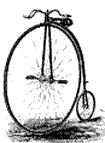Everyday Gear
Ok, so you are going for a 3 to 5 hour day ride with a group of NS Ramblers. You know that everyone in the group is or will be self sufficient for the day. That means you will be able to look after your personal safety, your physical needs and the needs of your bicycle for the day. Looking after your physical needs is a no brainer Food and water will power the engine of your bicycle. The engine is you.
Personal Safety:
Wear an approved bicycle helmet.
Know and follow rules of the road.
Ride single file.
Carry Identification with contact numbers and names
Carry your Health card because you never know.
Map of the route. Know where you are going
Jacket, lightweight for rain and/or wind.
Hydration:
Carry fluids. Water is best. Drink before you get too thirsty. Your body loses fluids even on a cold day.
Snacks:
Gel packs, energy bars, bananas, your own fruit/nut/candy mix or a sandwich are all good for
snacking on. Nibble something at least every hour to keep your energy up.
All of your bicycle’s needs should have been tended to prior to leaving home. Chains should be lubricated. Brakes have been adjusted. Nuts and bolts have been tightened. Tires are inflated. Despite your due diligence, things will happen on the road and tools will be required to fix them.
Tools and Equipment:
This is what you carry in your saddle/pannier bags.
A Multi Tool with hex wrenches up to 8mm, including a Philips and flathead screwdriver
A Chain Tool (your chain type) used to repair/replace/remove chain links
A Spoke Wrench to tighten spokes. Loose spokes are usually found when fixing a flat.
Zip ties and some Duct Tape. Red Green’s fix for everything.
Spare Inner Tube for your wheel and tire size to replace your first flat of the day.
Patch Kit to fix your second flat tire of the day. Either this or carry a second spare inner tube.
Tire Levers come in a pack of three but only two are actually needed.
A Mini Pump with both Presta and Shrader valve heads.
Rubber Gloves to keep your hands and everything else you touch free of grease, dirt and grime.
Crescent Wrenches, small, but large enough to fit on your wheel axle nuts if you don’t have
quick release wheels.
There are people who carry more tools and equipment, but at a minimum you should not leave home without the items listed here. Also, if you have one and most people do, carry a fully charged cell phone.
Bicycle Touring - What to take?
Suggestions submitted by Bob White.
For the Bike
Front (low rider) and rear racks, fenders, front & rear panniers, tool kit, two tubes, patch kit, pump, spare spokes, multi purpose bike tool, rack straps, two water bottles, bike light, front ( will double as camp light) and rear light, bell, spare tire, chain lube, rag, rain covers for panniers.
For the Cyclist
2 pairs of cycling shorts, cycling tights (can be part of rain gear), cycling gloves, cycling shoes, windproof breathable jacket (can be part of rain gear), helmet, 2 light shirts, and 1 warmer one, 3 pairs of socks,, one pair of wool socks, warmer cloths if spring / fall tour, 3 pairs of underwear, sweater for cool evenings, sandals, hat for warmth, sun protection.
For the Campground
Tent, including poles, pegs and waterproof full fly, ground sheet, sleeping bag, small pillow, good insulating air mattress pad, stove, fuel, matches, pot, small frying pan, mug, cup, and utensils, can opener, pot lifter, flipper, dish soap, dish towel and scrapper, food for emergency (can of tuna, ham, instant rice / potatoes, packaged soup, spices), towel, face cloth, deodorant, shampoo, $.25's (for showers), clothes soap, tooth bush & paste, comb, toilet paper, 1st aid kit, bug repellent, candle and personal medication.
Other
MSI / Hospital card, emergency contact #, let someone know your travel plans before you go, wallet, money credit cards, sun glasses, Ziploc bags, maps, length of cord (clothesline, etc.), camera.(You should now have about 45 pounds / 20kg) of cargo.)
Hints
Roll clothing tight and pack in Ziploc bags, keep weight to a minimum. Practice loading and unloading and ride the bike before tour - adjust cargo accordingly. Try to keep stuff in same location to save time searching for items - some cyclists have pannier "charts" for each pannier. I like a handlebar bag and keep my wallet, map, tools, spare tube and snacks handy. Wear bright coloured cloths and dress for the conditions. When "loaded", plan to cycle at a modest pace. If traveling a distance, leave early, rest during mid day heat. Set up camp as soon as arriving, and then have shower to avoid evening "chills". Eat well, and often - you will burn 600+ calories an hour - lots of fruits and veggies - they are power foods. Stay hydrated - this will reduce chance of leg cramps; I also take Tums, as I feel they have both calcium and help prevent leg cramps. I also take powdered Gatorade to replace lost electrolytes. If it rains all day, I look for a B&B / motel as I want to enjoy my tour. Book campsites ahead of time.
Before arriving at the campsite, I plan to stop at the last available outlet for fresh food for dinner, breakfast. Quite often we tour in groups; it is nice to coordinate meals with other cyclists, for both economy and variety.
Travel with a sense of humour and camaraderie; be sure to offer assistance to your fellow cyclists.
Enjoy yourself - Have Fun
